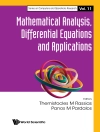Bifurcation theory is a major topic in dynamical systems theory with profound applications. However, in contrast to autonomous dynamical systems, it is not clear what a bifurcation of a nonautonomous dynamical system actually is, and so far, various different approaches to describe qualitative changes have been suggested in the literature. The aim of this book is to provide a concise survey of the area and equip the reader with suitable tools to tackle nonautonomous problems. A review, discussion and comparison of several concepts of bifurcation is provided, and these are formulated in a unified notation and illustrated by means of comprehensible examples. Additionally, certain relevant tools needed in a corresponding analysis are presented.
Table of Content
Introduction.- Part I Nonautonomous differential equations – Spectral theory, stability and continuation.- Nonautonomous bifurcation.- Reduction techniques.- Part II Nonautonomous difference equations – Spectral theory, stability and continuation.- Nonautonomous bifurcation.- Reduction techniques.












